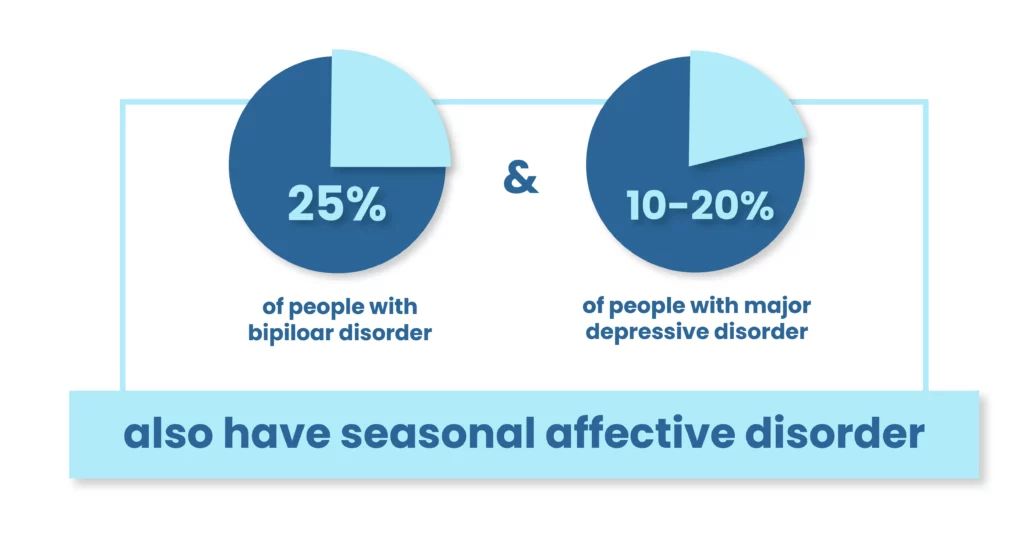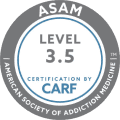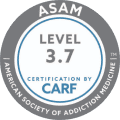
A subtype of depression or bipolar disease that starts and ends around the same time every year is seasonal depression, often known as seasonal affective disorder (SAD) or the “winter blues.” Most symptoms of seasonal depression usually start in the fall and last through the winter. It typically happens when the seasons change. Though it is less frequent, seasonal depression can also occur in the spring or early summer.
Individuals with other mental health conditions are more likely to experience SAD. Around twenty-five percent of people with bipolar disorder and ten to twenty percent with major depressive disorder also have SAD.
Common Symptoms of SAD
It can often be challenging to distinguish between seasonal depression and other types of depression because the symptoms of the seasonal affective disorder are sometimes similar to those of depression. The signs of carbohydrate seeking, increased appetite, excessive drowsiness, and weight gain are often more prevalent in seasonal depression than in other types of depression.
After two consecutive episodes of depression that start and end at the exact time every year and the symptoms go away the rest of the time, a diagnosis of seasonal depression can be made. Seasonal affective disorder has specific symptoms that can include:
- Loss of interest in activities you used to enjoy frequently
- Depression and low self-esteem
- Changes in appetite and weight;
- Experiencing rage, annoyance, stress, or worry
- Unaccounted-for aches and discomfort
- Modifications in sleeping habits
- Trouble concentrating
- Low sex drive, lack of energy, and fatigue
- Comfort-related addiction to alcohol or
- substance abuse
- Sadness and feelings of helplessness,
Risk Factors for The Seasonal Affective Disorder (SAD)
Researchers don’t know the exact cause of the SAD or seasonal affective disorder. Seasonal changes and Less sunlight may trigger the condition if you are prone to affect by SAD. The following are common risk factors of Seasonal affective disorder.
Family History: Many people who suffer from seasonal sun affective disorder have family members who suffer from other mood or psychological illnesses such as major depressive disorder or schizophrenia. According to studies, 25 to 67 percent of those suffering from seasonal affective disorder have a family with the condition.
They share some genetic risk factors with seasonal affective disorder, and these other diseases may run in families. However, because these ailments are relatively prevalent in the general community, they may haphazardly affect more than one family member.
Biological Clock Change: Your biological clock changes as the number of sunlight decreases. This internal clock controls your hormones, mood, and sleep patterns. You can’t adjust to variations in the length of the day when it moves because you are out of sync with your regular daily routine.
Unbalanced neurotransmitters, which communicate between nerves, exist in the brain. Serotonin is one of these molecules, and it helps people feel happy. If you are susceptible to SAD, your serotonin levels may already be low. Less or lack of sunlight in the winter can exacerbate the problem because sunlight helps regulate serotonin. Depression may result from a further decline in serotonin levels.
Vitamin D Deficiency: Vitamin D also raises your serotonin levels. Because vitamin D is produced partly by sunlight, a lack of the sun during the winter might cause a vitamin D shortage. That alteration may impact the serotonin level and your mood.
Melatonin Boost: A hormone called melatonin influences your emotions and sleeping patterns. In some persons, the lack of sunlight may encourage excess melatonin production. During the winter, you could feel sluggish and tired.
Negative Thoughts: People who suffer from SAD frequently feel stressed, anxious, and depressed and have sexual problems during the winter. According to researchers, these negative thoughts may cause seasonal depression.
Treatment for Seasonal Affective Disorder (SAD)
Seasonal affective disorder can cause trouble carrying out daily routines, relationships, and mental health issues. But the good news is treatment is available. Increased sun exposure may benefit some people with SAD symptoms. For instance, spending time outdoors or setting up your house or business exposes you to a window during the day. However, exposure to the sun’s UV rays can raise your risk of skin cancer.
It would also be best to discuss the advantages and disadvantages with your doctor. Taking care of your overall health and wellness can also be beneficial; this includes regular exercise, eating well, getting enough sleep, and keeping active and engaged through volunteer work, joining clubs, and spending time with friends and family.
However, when it develops, there are several effective treatments for SAD, including light therapy, antidepressants, talk therapy, or a combination of these. While symptoms typically get better on their own as the seasons change, they can get better faster with treatment.
Light Therapy: Sitting in front of a light therapy box that emits a bright light and blocks harmful ultraviolet (UV) radiation is a common light therapy technique. During the winter, it normally takes at least twenty minutes per day, usually first thing in the morning. Within one to two weeks of starting light therapy, most patients experience some benefits. The benefits of treatment are typically maintained throughout the winter to avoid recurrence. Some patients may start light therapy in the early fall to prevent symptoms because late fall is when symptoms are expected to reappear.
Talk Therapy: People with seasonal depression may find great benefits from cognitive behavioral therapy (CBT). The correct therapist can teach you how to manage symptoms and healthily cope with stress while also assisting you in reducing harmful ideas, attitudes, and actions that exacerbate the disease. Many patients find that CBT can treat SAD as effectively as light therapy or antidepressants without any unfavorable side effects.
Medications: If t light therapy is ineffective for you, your doctor might advise antidepressant medicines. SSRI antidepressants improve SAD symptoms by raising serotonin levels in the brain. The FDA has specially approved bupropion (Wellbutrin) in the United States for seasonal affective disorder. However, there could be adverse side effects, including some safety issues particular to children and young adults, as with all antidepressants. Before beginning a medicine, it’s critical to consider the dangers and advantages.
Whatever treatment plan you choose for yourself and your family member, it’s essential to utilize self-help techniques to manage your depression symptoms and even help prevent seasonal affective disorder from returning next year.
Seek Professional Help: It is crucial to confirm that the symptoms are caused by a medical issue, like other types of depression. A comprehensive evaluation is essential since SAD can be incorrectly diagnosed in hypothyroidism, hypoglycemia, infectious mononucleosis, and other viral illnesses. An expert in mental health can diagnose and go over treatment choices. SAD is a disorder that is treatable with the proper medication.
If you feel symptoms of seasonal affective disorder, seek the help of a skilled medical professional by reaching out to The Haven Detox in New England. You will able to choose
the most suitable treatment program for yourself and your family members.
Quick Tips to Cure Seasonal Affective Disorder at Home
There is currently no known technique to stop seasonal affective disorder from occurring. However, if you take action to manage your symptoms as soon as possible, you might be able to prevent them from getting unwanted side effects over time.
As you can anticipate the season in which these symptoms may begin, you may be able to prevent severe changes in mood, weight loss, appetite, and energy levels. Treatment can help avoid problems, particularly if SAD is identified and treated before symptoms become severe.
Some people find it beneficial to start their treatments in the fall or winter, before symptoms typically appear, and to continue them far after symptoms would ordinarily go. Others require ongoing care to prevent the recurrence of their problems. Following are some valuable tips that can help you to deal with seasonal affective disorder.
- Get as much sunlight as you can
- Spend time with old friends
- Add a healthy diet to your eating menus, such as fruits, vegetables, fresh juices, and milk, and the list goes on.
- Exercise regularly.
- Keep yourself busy. Engage yourself in activities like your job and everyday tasks.
Frequently Asked Questions (FAQs)
How does SAD affect people?
SAD, a seasonal affective disorder, is a type of depression. It can impact your mood, sleep, food, and energy levels. It can also negatively impact your work, school, relationships, and self-worth.
What is the likely cause of seasonal affective disorder?
Shortening days and lack of sunlight are associated with a chemical change in the brain and may be part of the cause of SAD. Melatonin, a sleep-related hormone, also has been linked to SAD. The body naturally makes more melatonin when it’s dark.
Is SAD bipolar?
Seasonal affective disorder (SAD) is a mood disorder characterized by depressive symptoms that respond to seasonal weather and climate changes. It is a subtype of major depressive disorder and bipolar disorder.
How long does SAD last?
Depression known as Seasonal Affective Disorder (SAD) happens yearly around the same time. Even though it can occur in either spring or summer, it usually starts in late fall and lasts until the end of winter.
How common is SAD?
According to research, SAD typically lasts for around forty percent of the year and affects roughly five percent of young people in America. Women experience it more frequently than men do. Shorter days and less sunlight throughout the winter are thought to cause SAD, linked to a biochemical imbalance in the brain.
This Season, Get Help from The Haven Detox In New England
The Haven Detox in New England is a qualified mental health and addiction treatment provider in the United States of America. We aim to help people by making them feel at ease during withdrawal and recovery.
At The Haven Detox in New England, we offer several treatment options, including a Residential Treatment program, Dual Diagnosis, and Cognitive behavioral therapy (CBT) to fight seasonal affective disorder ( SAD) in a safe environment. Don’t battle your mental health issues or addiction on your own.
The Haven’s experienced team can help provide relief. If you or a loved one is struggling, contact our counselors today at (844) 933-4145. Our admissions counselors are available 24/7 and happy to answer all your questions.



